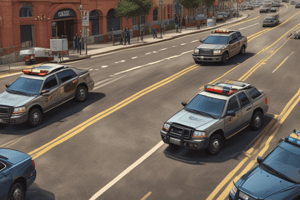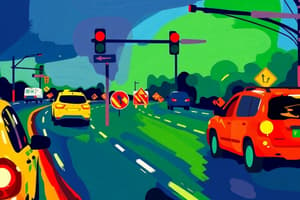Podcast
Questions and Answers
In the context of traffic incident management, what is the primary role of the 'Block'?
In the context of traffic incident management, what is the primary role of the 'Block'?
- To manage and direct traffic flow around the incident, ensuring minimal disruption.
- To position an apparatus at an angle to approaching traffic, effectively shielding the incident scene. (correct)
- To serve as a visual warning to approaching motorists about the incident ahead.
- To create a safe zone exclusively for parking of medic units and ambulances.
Under what circumstances, according to TFD policy, may personnel remove structural PPE in an emergent traffic zone?
Under what circumstances, according to TFD policy, may personnel remove structural PPE in an emergent traffic zone?
- During daylight hours to improve visibility and communication among team members.
- When the Incident Commander deems the PPE too cumbersome for the task at hand.
- Only when activities do not involve fire suppression, standby with hose lines, or extrication.
- If actively involved in ALS procedures or providing emergent BLS care, and the PPE hinders patient care. (correct)
What is the recommended action for TFD personnel regarding traffic when placing or retrieving traffic cones and flares in emergent traffic zones?
What is the recommended action for TFD personnel regarding traffic when placing or retrieving traffic cones and flares in emergent traffic zones?
- Prioritize speed to minimize time spent in the traffic zone.
- Turn their back to moving traffic for better leverage and balance.
- Face oncoming traffic at all times to maintain visual awareness. (correct)
- Rely on the lookout for warnings of approaching vehicles.
In freeway operations, how should freeway lanes be numbered for effective incident scene management, according to the provided guidelines?
In freeway operations, how should freeway lanes be numbered for effective incident scene management, according to the provided guidelines?
What is the primary consideration for positioning medic units and private ambulances that are downstream from an incident?
What is the primary consideration for positioning medic units and private ambulances that are downstream from an incident?
According to the guidelines, which of the following actions should the Incident Commander undertake regarding flashing lights at a roadway incident scene?
According to the guidelines, which of the following actions should the Incident Commander undertake regarding flashing lights at a roadway incident scene?
When apparatus numbers are limited, what is the prioritization for blocking exposed sides of an incident in a roadway or intersection?
When apparatus numbers are limited, what is the prioritization for blocking exposed sides of an incident in a roadway or intersection?
What is the recommended minimum distance for placing traffic cones upstream of the blocking apparatus to delineate a buffer zone?
What is the recommended minimum distance for placing traffic cones upstream of the blocking apparatus to delineate a buffer zone?
According to TFD policy, what is the appropriate action if the department-issued uniform service coat has reflective striping and personnel are working in an emergent traffic zone?
According to TFD policy, what is the appropriate action if the department-issued uniform service coat has reflective striping and personnel are working in an emergent traffic zone?
When positioning the first-arriving apparatus at an incident, what specific action must be taken with the front wheels, and why?
When positioning the first-arriving apparatus at an incident, what specific action must be taken with the front wheels, and why?
Flashcards
Advance Warning
Advance Warning
A visual indicator to warn drivers of an upcoming hazard
Block
Block
Positioning a vehicle to protect an incident scene from moving traffic. Usually done at an angle.
Buffer Zone
Buffer Zone
A safe area or distance between the protected work zone and moving traffic.
Downstream
Downstream
Signup and view all the flashcards
Emergent Traffic Zones
Emergent Traffic Zones
Signup and view all the flashcards
Patient Loading Zone
Patient Loading Zone
Signup and view all the flashcards
PPE
PPE
Signup and view all the flashcards
Upstream
Upstream
Signup and view all the flashcards
Work Zone
Work Zone
Signup and view all the flashcards
Freeway Lane Numbering
Freeway Lane Numbering
Signup and view all the flashcards
Study Notes
- TFD Policy 5031 outlines safety practices to protect TFD personnel near moving traffic at incident scenes.
- Applies to ALL TFD personnel.
- The policy replaces Traffic Work Zones policy dated November 2001.
Responsibilities
- The Administrative Battalion Chief for Safety is responsible for maintaining this document.
- Incident Commanders are responsible for ensuring overall personnel safety, enforcing safety policies, ensuring proper PPE use, assigning an Incident Safety Officer, and coordinating with law enforcement.
- Incident Safety Officers are responsible for ensuring a protected work zone, monitoring traffic, and assisting with PPE compliance.
- All TFD personnel must know and execute safety policies for traffic work zones.
Definitions
- Advance Warning: Visual indication to warn motorists of roadway hazards.
- ALS: Advanced Life Support.
- Ambulance: A private ALS or BLS unit assisting in patient transport.
- Apparatus: Mobile TFD firefighting or specialized equipment.
- Block: Positioning a vehicle at an angle to protect the incident scene.
- Buffer Zone: Safe space between the work zone and moving traffic.
- Downstream: Area where traffic flow leaves a roadway incident.
- Emergent Traffic Zones: Operation areas on or near active roadways, including accidents, fires, downed power lines, and brush fires.
- Patient Loading Zone: Area behind a medic unit or ambulance for patient loading.
- PPE: Personal Protective Equipment.
- Upstream: Area where traffic flow approaches a roadway incident.
- Work Zone: Safe area for personnel, medics and patient loading.
General Guidelines
- Incident Commanders evaluate and control traffic flow, coordinate with law enforcement, and remove personnel/equipment promptly.
- Personnel must protect themselves first, then the scene, operating defensively, maintaining awareness and never trusting moving traffic.
Clothing Guidelines
- High visibility/reflective vests are required on TFD apparatus.
- Personnel in emergent traffic zones must wear structural firefighting helmets.
- Firefighting PPE is required for activities involving fire suppression or extrication.
- High visibility/reflective vests and helmets are required when not wearing structural PPE.
- Personnel may wear high visibility/reflective vests over structural PPE.
- Uniforms alone are not sufficient in traffic zones.
- Orange high-visibility vests are prohibited when actively fighting fires.
- Department-issued uniform service coats with reflective striping alone are not adequate.
Apparatus Positioning
- First arriving apparatus must be in a block position with wheels turned away from the work zone.
- Position apparatus at a minimum 45-degree angle to upstream traffic at a sufficient distance to prevent intrusion into the work zone.
- In intersections or middle of roadways, attempt to block all exposed sides.
- Prioritize blocking the closest, highest speed, and highest volume approaching traffic.
- Park with the pump panel downstream and on the opposite side of oncoming traffic for hose line needs, following TFD policy 5006.
- Park medic units and ambulances to position the patient loading zone within a protected work zone.
- Angle downstream ambulances in a block position if needed.
- Park medic units and ambulances in driveways at residential emergencies.
Freeway Operations
- Number freeway lanes from right to left facing the direction of travel.
- Incident Commanders must evaluate the need for apparatus, specify parking locations, coordinate with authorities, manage termination carefully, and promptly return unneeded apparatus.
- The first arriving company parks in a block position.
- The second arriving company creates a buffer zone 150 to 200 feet upstream.
- Park remaining apparatus downstream if possible.
- Stage medic units and ambulances as needed.
- Park medic units and ambulances to establish a safe patient loading zone downstream of the blocking apparatus.
- TFD personnel cannot remain in an open freeway lane outside the protected work zone.
Safety Guidelines in Emergent Traffic Zones
- Stop traffic flow or reduce it to a safe pace if personnel safety is compromised.
- Incident Commanders evaluate and communicate escape routes.
- Reduce flashing light use to minimize vision impairment for motorists.
- Provide specific directions for traffic control to law enforcement.
- Designate an Incident Safety Officer to warn personnel.
- The first arriving company places traffic cones to direct traffic.
- Place traffic cones a minimum of 150 feet upstream of the blocking apparatus to delineate a buffer zone.
- Place traffic cones to designate the protected work zone.
- Expand traffic cone placement as needed.
- Consider using flares with traffic cones at night or in poor weather.
- Do not use flares near flammable gas or liquid spills.
- Increase initial traffic cone distances based on weather conditions.
- Look before exiting apparatus, exit on the curb side when possible, walk close to apparatus, stop and look before proceeding around apparatus, and face oncoming traffic while placing/retrieving cones and flares.
- Personnel must never turn their back on moving traffic while placing or retrieving cones and flares.
Studying That Suits You
Use AI to generate personalized quizzes and flashcards to suit your learning preferences.




